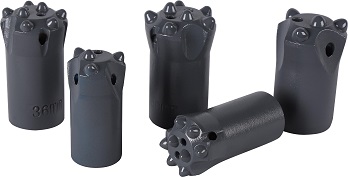Abstract:Tapered button bits are widely used in drilling applications and play a crucial role in the mining and construction indu...
Tapered button bits are widely used in drilling applications and play a crucial role in the mining and construction industries. As a manufacturer specializing in the production of tapered button bits, it is essential to understand the manufacturing process and the relevant standards that govern their production.

The production of tapered button bits involves several key steps to ensure their quality and performance. Firstly, high-quality raw materials, typically alloy steel, are carefully selected for their durability and resistance to wear and tear. These materials undergo rigorous testing and inspection to meet the specified standards.
Next, the manufacturing process begins with precision machining. The raw material is shaped into the desired taper profile, ensuring the correct dimensions and angles. This step requires advanced machining techniques and specialized equipment to achieve the necessary accuracy.
After the initial machining, the tapered button bits undergo heat treatment to enhance their hardness and toughness. This heat treatment process involves carefully controlling the temperature and cooling rate to achieve the desired mechanical properties. Proper heat treatment ensures that the bits can withstand the harsh conditions encountered during drilling operations.
Following heat treatment, the tapered button bits undergo further machining to create the button inserts. These inserts, typically made of tungsten carbide, are strategically positioned on the bit's face to provide efficient drilling and rock-breaking capabilities. The machining of the inserts requires precision and expertise to ensure proper alignment and secure attachment to the bit.
In addition to the production process, tapered button bits are subject to various standards and specifications to ensure their quality and compatibility with drilling equipment. These standards include dimensions, tolerances, thread specifications, and material requirements. Adhering to these standards is crucial to ensure the interchangeability and compatibility of the tapered button bits with different drilling systems.
As a manufacturer, it is essential to maintain strict quality control throughout the production process. This includes rigorous inspection and testing of the finished tapered button bits to verify their dimensional accuracy, hardness, and performance. These quality control measures guarantee that the produced bits meet or exceed the required industry standards.
Collaboration with customers and industry experts can provide valuable insights into specific drilling applications and challenges, allowing for the customization of tapered button bits to meet unique requirements. This customer-centric approach ensures that the produced bits are optimized for maximum efficiency, productivity, and cost-effectiveness.
Furthermore, a comprehensive understanding of international standards and regulations pertaining to tapered button bits is crucial, especially when catering to a global customer base. Compliance with these standards not only ensures product quality but also facilitates seamless integration and compatibility with various drilling systems worldwide.
To maintain a competitive edge in the market, it is essential to invest in modern manufacturing facilities, advanced machinery, and skilled workforce. Embracing automation and digitalization technologies can streamline the production process, enhance efficiency, and improve overall product quality.
As a manufacturer of tapered button bits, Kaiqiu a commitment to excellence, continuous improvement, and customer satisfaction are vital. By adhering to stringent production processes, staying abreast of industry trends, and prioritizing quality and innovation, a factory can establish itself as a reliable supplier of high-performance tapered button bits, meeting the diverse needs of the mining and construction sectors globally.

 简体中文
简体中文 English
English España
España русский
русский
